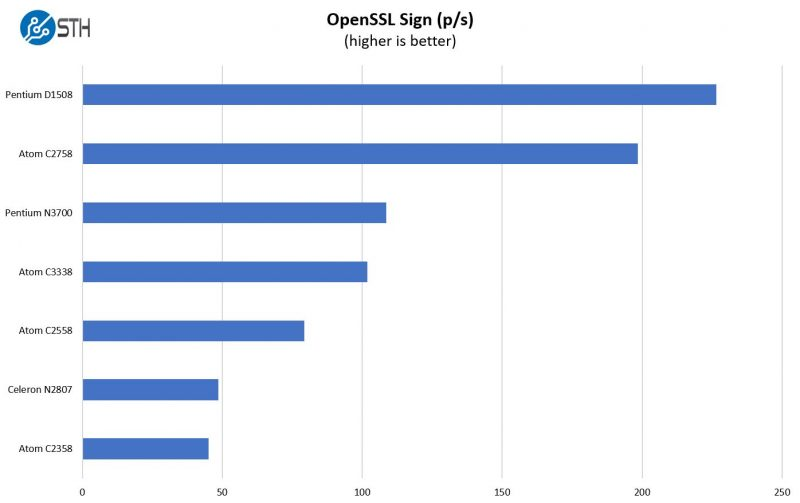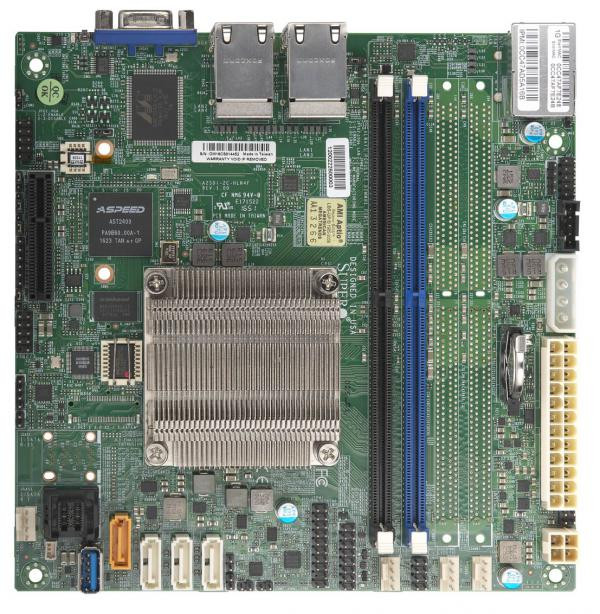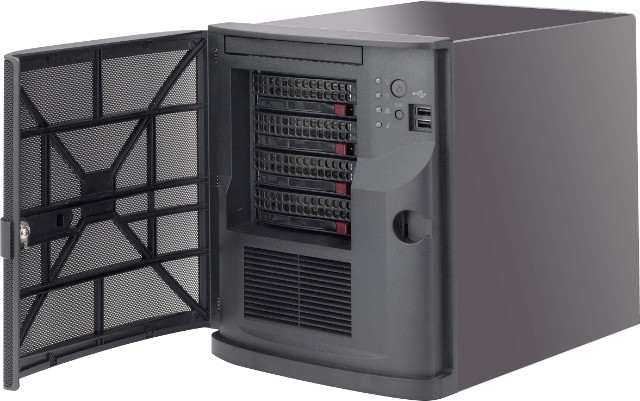Almost exactly one year ago, I wrote about Intel Atom C3000 Series “Denverton” processor based on the same Goldmont architecture used in Apollo Lake processor, and used in an early GIGABYTE MA10-ST0 server motherboard prototype. The latter is not out yet, but according to a YouTube video, the 16-core motherboard should be launched in H2 2017. In the meantime, Supermicro also made their own Denverton motherboard based on a lower-end Atom C3338 dual core processor.
Supermicro A2SDi-2C-HLN4F board specifications:
- Processor – Intel Atom C3338 dual core Denverton processor @ 1.50 / 2.20 GHz with 4 MB cache; 9W TDP
- System Memory
- Up to 64GB Register DIMM RDIMM and DDR4-1866MHz
- Up to 32GB Unbuffered ECC/non-ECC UDIMM, DDR4-1866MHz, in 2 DIMM slots
- Storage – 4x SATA 3 ports, but up to 8x SATA 3 (6 Gbps) ports are configurable; N.B.: total combined PCI-E lanes and SATA ports is up to 8
- Connectivity – 4x GbE Ethernet via Intel C3000 SoC
- USB – 4x USB 2.0 ports including 2x via headers, 1x USB 3.0 port
- Expansion – 1x PCI-E 3.0 up to x4 (in x4 slot); number of PCI-E lane is configurable via BIOS setup: 0, 2, or 4.
- Video Output – VGA
- Serial – 1x COM port via header
- IPMI & 2D Graphics – ASPEED AST2400 BMC
- Misc – TPM header; AMI UEFI 2.4/SMBIOS 2.7.1 “BIOS”; HW monitoring: 4-fan status and tachometer, CPU voltage monitoring, system temperature, VBAT, etc…
- Power Supply – ATX power connector; 12V DC power input; CPU thermal trip support for processor protection; power-on mode for AC power recovery
- Dimensions – 17.02cm x 17.02cm (Mini-ITX)
- Temperature Range – Operating: 0°C ~ 60°C; storage: -40°C – 85°C
The board supports Windows 64-bit operating systems like Windows 10, Windows Server 2016, Hyper-V Server 2016, etc.. as well as various 64-bit Linux distributions such as RedHat Linux EL 7.3, Fedora 25, SuSE SLES 11 SP4, Ubuntu 16.04 LTS and others, as well as FreeBSD. You may find the full list here.
If you’d like a complete system, the company also offer SuperServer 5029A-2TN4 with the board, and the company’s SC721TQ-250B mini tower with four hot-swap 3.5″ SATA drive bays, two internal 2.5″ drive bays, and 1 slim DVD-ROM drive bay shared with one internal 2.5″ bay.
Supermicro A2SDi-2C-HLN4F motherboard is sold for just above $200 on websites such as Atacom and WiredZone. I found the barebone “SuperServer” sold for $405 on Newegg. The latter has been reviewed on ServeTheHome in April with the conclusion rather positive:
If you are looking for a 1GbE NAS unit, this is a great option. The performance is well above the previous generation dual core and sometimes quad core models. The ability to maintain a low power profile will help ROI.
Over time, we expect to see better support for the X553 NIC. The major competition for this unit will be when the higher core count variants come out and iterations that support 10GbE.
In many environments, this is going to be a perfect NAS/ network services platform. If you wanted a simple 1GbE Linux NAS or caching appliance, the Supermicro SYS-5029A-2TN4 should be high on your list.
They also ran several benchmarks to put the CPU performance into perspective.

You’ll find more details about the motherboard on the product page.
Thanks to Paul for the tip.

Jean-Luc started CNX Software in 2010 as a part-time endeavor, before quitting his job as a software engineering manager, and starting to write daily news, and reviews full time later in 2011.
Support CNX Software! Donate via cryptocurrencies, become a Patron on Patreon, or purchase goods on Amazon or Aliexpress







The board has a mini SAS connector for the additional four SATA ports, that’s the black square near the SATA ports. It either connects to a backplane or you use a splitter cable from one to four ports.
You glossed-over the key problem with this thing: As you quoted from the April ServeTheHome Review: “Over time, we expect to see better support for the X553 NIC.” See their March 2017 article.
This is a BIG RED FLAG that says: “Wait 6-12 months for mainstream drivers before buying.” Of-course by that time the board will no longer be stocked and there will be a new faster & cheaper board out with yet-again new unsupported peripherals. And the vicious never-ending Linux Missing-Driver Hell cycle repeats.
@Drone
> You glossed-over the key problem with this thing
Another key problem is the price to performance. There are no passmark scores for the C3338, and unfortunately also not for the D1508, but I found the Xeon D-1518 scored 4700. If we take the “kernel compiles per hour” as the factor, then the C3338 scores 0.6 and the D-1518 scores 1.95. So the Xeon D-1518 is 3.25x faster. Taking this into account and assuming linear performance, we can get a “passmark” score on the C3338 of 1446.
For $200.
This is on par with the N54L found in the HP Microserver G7 which scores 1376 in passmark. Sure, you cannot use 64GB RDIMMs in the N54L, but you can buy a complete Microserver G7 today on eBay for under $100 (compared to $400 for the Supermicro barebones system).
If that doesn’t meet your taste, you can go out and buy a brand new Microserver G8 for under $180 which will smoke this Atom (2322 versus ~1400).
The only use I can see for this is low power (9W TDP versus 35W for the G1610T), but then why wouldn’t you just buy an ARM like the MACCHIATOBin? It even has working Gigabit and 10GBit out of the box.
This board is nothing but an overpriced Atom with dismal performance.
> Of-course by that time the board will no longer be stocked and there will be a new faster & cheaper board out with yet-again new unsupported peripherals.
Oh, and unsupported devices. Avoid at all costs.
@Mum
this is an Atom processor, so will have pretty poor performance compared to the Xeon D-1518
compare it with the faster J3355 Apollo Lake processor
http://ark.intel.com/compare/91201,97928,95597
the J3355 has a cpubenchmark of 1313 which is pretty lowly, so the C3338 will probably be slower
http://www.cpubenchmark.net/cpu.php?cpu=Intel+Celeron+J3355+%40+2.00GHz&id=2960
@Mum
The SuperMicro is targeted at data centers while the G7 is targeted at SMBs and doesn’t have features like IPMI or SATA DOM support. Which if fine if you don’t need them, why pay for it? I have a ASRock C2750 (FreeNAS) and SuperMicro C2758 (pfSense) and they’re both perfect for what I use them for but yes, they’re dog slow for general computing.
@Drone
The issue ServeTheHome brings up is that the older versions of the linux ixgbe driver don’t recognize the device id of the X553 so the driver won’t load. So it’s not a “new” driver or even radically new controller, it’s Intel’s proven 10gbe logic embedded into the C3000 SoC and they gave it a new device ID because there certainly have been some changes to weld it into the SoC. To my knowledge no one has reported any problems with it beyond getting old distros to recognize it because of the new device ID.
@Sandbender
> The SuperMicro is targeted at data centers
> but yes, they’re dog slow for general computing.
So why on earth would anyone put this garbage in their data center? It has neither the density nor computing power they’re looking for.
If you’re looking for a cache server, you’re probably already looking at a Xeon which can take hundreds of gigabytes of RAM. 64GB is small potatoes in the data centre even for 2009 (L5520 supports 96GB).
This thing is a lame duck regardless of the market. It’s too expensive compared to alternatives for home users, and it’s too wimpy for enterprise.
I could see it being used in networking equipment as the management processor (like Cisco has done previously) but apart from that, I can’t see any practical use for this thing.
> it’s Intel’s proven 10gbe logic embedded into the C3000 SoC and they gave it a new device ID because there certainly have been some changes to weld it into the SoC
The board specifications only list 4x1GBit interfaces. There is no 10GBit interface on this board.
@Mum
I didn’t say it was a popular product or even a wise one, just that’s what it’s targeted at. It’s a very niche market to be sure but it’s popular for lower-end (=> 1gig) routers/vpn servers, SSL proxy endpoints and SMB NAS servers (the C27x8’s with QuickAssist crypto/zlib acceleration which lets the chip punch well above it’s weight for SSL). They can also be a good choice for enterprise cold storage servers where idle power consumption is just as important as speed. But I’m not arguing with you, and Intel isn’t either… they’re not really rushing the other C3000 sku’s to market to replace the C2000s. Part of that is the hit they took making the warranty replacements for the C27xx’s because of the POST issue but more competitive options have come out in the space Marvell… which the MACCHIATOBin you mentioned is based on… Amazons (Annapurna’s) Alpine, etc. I think they’re waiting to see how the two core version is picked up before they decide what to do next.
> The board specifications only list 4x1GBit interfaces. There is no 10GBit interface on this board.
The Intel X553 is a 10Gb controller. It’s married with 1GB MACs on these boards because there’s no chance a dual core atom is going to keep up with 10Gb. The 16 core part is/was supposed to ship with 10Gb MACs.
@Sandbender
> because there’s no chance a dual core atom is going to keep up with 10Gb
Shouldn’t the NIC handle offloading most of the effort of 10Gb? Obviously the OS has to get involved at some point, and a dual core Atom isn’t going to be able to serve video or HTTP requests at 10GBit.
I guess the answer is: it can do about 4GBit, which would explain their choice of MACs for this board 😉
@Mum
It depends on what you’re doing with the data going over the NICs. If it’s a straight bridge with packets just being shuttled back and forth (basically a switch) then they should be able to handle it as the NIC is doing most of the work. If you’re doing any type of packet inspection (filtering based on IP, port) or QoS then the CPU will be handling that. Unless you’re using SoC like the Marvell chipset in the MACCHIATOBin then it can hit the CPU hard. The unit of measure here is not really bps because good NICs are doing DMA transfer, it’s packets per second. You’ll notice that high end firewall vendors will include pps for different packet sizes, typically 1500, 500 and 64. If you’re streaming video the packets will probably be 1500 bytes, if you’re sitting in front of DNS or NTP server the packets are going to in the 64-128 byte range. A firewall for a DNS server has to do roughly ~15x the inspections of one in front of a streaming server (that a very rough WAG but illustrates the problem).
I think the Gigabyte board with twin gigE’s and the J3455 is a better bet unless you really want four integrated NICs
http://www.cnx-software.com/2017/04/18/gigabyte-ga-j3455n-d3h-apollo-lake-mini-itx-motherboard-comes-with-2x-gigabit-ethernet-interfaces-4x-sata-ports/
at least the CPU isn’t a slug, likely to be much much faster than this Denverton Atom.
http://www.cpubenchmark.net/compare.php?cmp%5B%5D=2960&cmp%5B%5D=2875
@Sandbender
Hmmm… I suppose you’re referring to the NIC vendor’s PID (if such exists) and not the vendor part of the MAC address (a MAC addr is trivial to spoof anyway)? If-so, isn’t there a way to spoof the ID in something like /etc/udev/rules.d? If yes, that should make the problem go away with just a minor tweak.
@Mum
If you’re arguing about price/performance, then this board is not for you.
IMHO, These are the important specs for this board:
1. Mini-ITX
2. ECC memory
3. RDIMM ECC memory
4. Up to 8 SATA 3 ports
5. Sub 10W operating TDP.
There is only 1 thing this motherboard was ideally suited for: A low-cost, 8-bay ZFS NAS appliance. Try to find a motherboard that aggregates even the first 4 bullet points on the list above and you will see how much of a bargain this motherboard is at about $200.
The only bad thing about this board is the current lack of driver support for the onboard NICs in FreeBSD.
@Paul M
The performance of the CPU on this motherboard shouldn’t be your primary focus. The rich and very specific feature-set is what should draw your attention. If it doesn’t, then this board (or even catgegory of boards) is not for you, please move along.
@Paul M
Or ECC memory support or 8 SATA ports…or IPMI…
Try to find ECC memory support in any board under $200, much less one with a CPU.
I agree with your assessment on the NIC drivers, but I would like to point out that this is only the first of the Denverton chips. The rest of the line may take as much as 6-12 months (or more) to be fully released. By the time we see the full hog 16-core models, at least the mainstream Linux distros should have drivers available…FreeBSD may have to wait a bit longer…